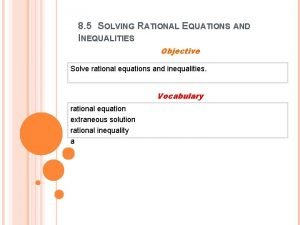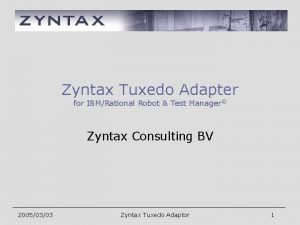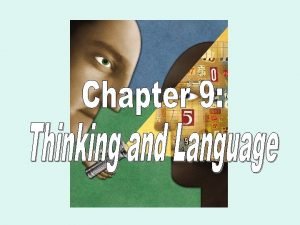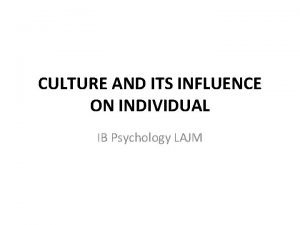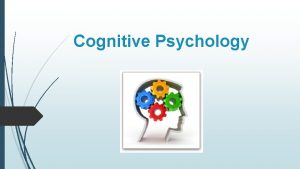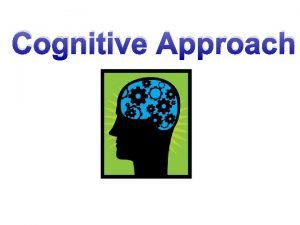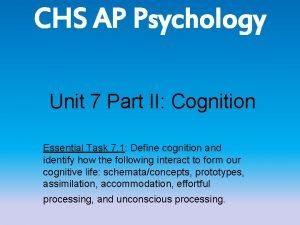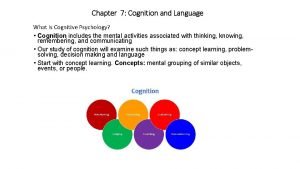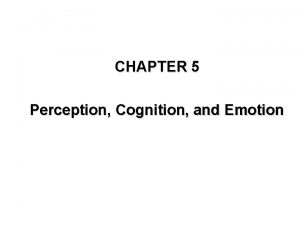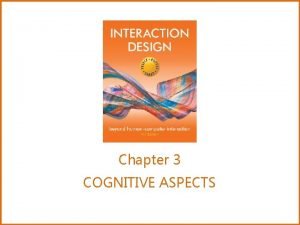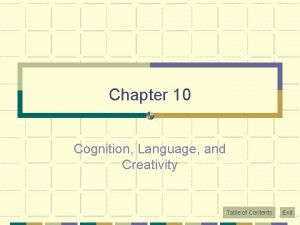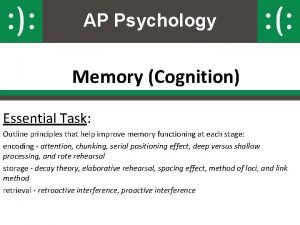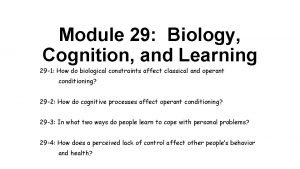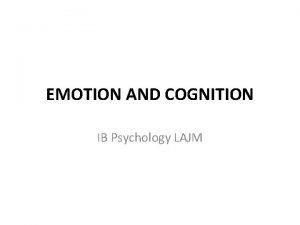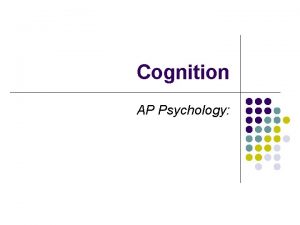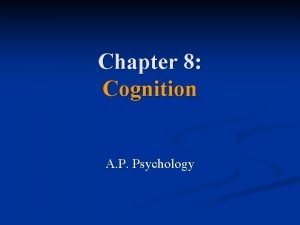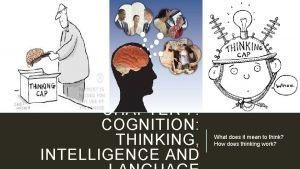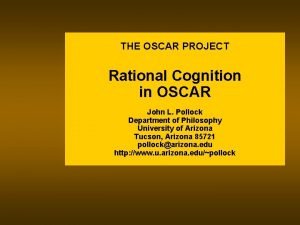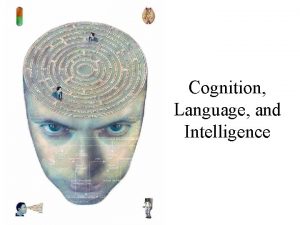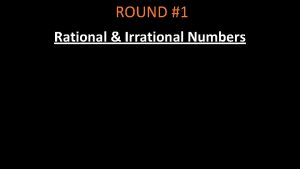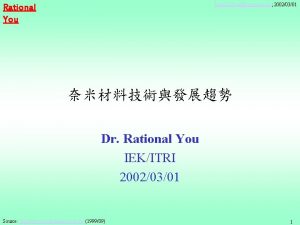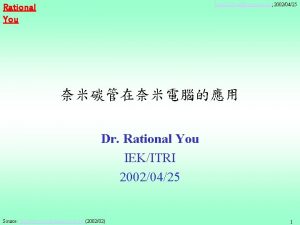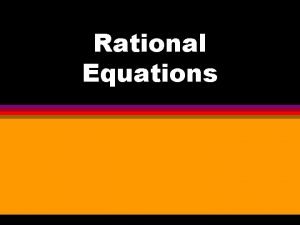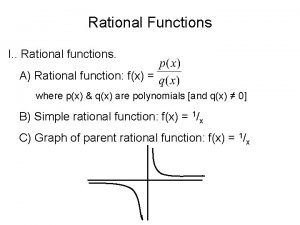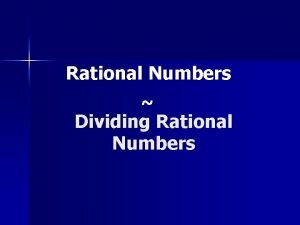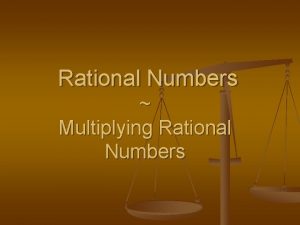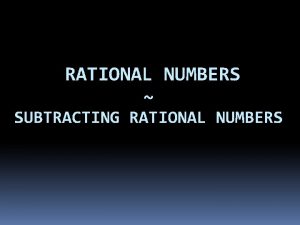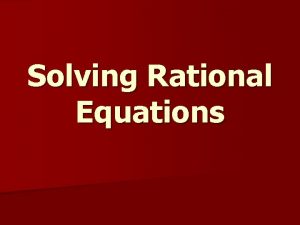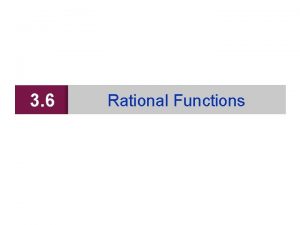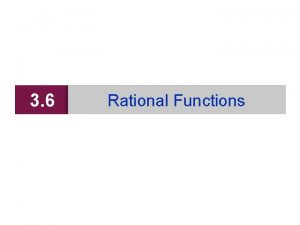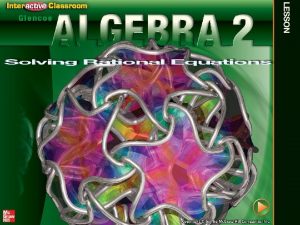THE OSCAR PROJECT Rational Cognition in OSCAR John
























- Slides: 24

THE OSCAR PROJECT Rational Cognition in OSCAR John L. Pollock Department of Philosophy University of Arizona Tucson, Arizona 85721 pollock@arizona. edu http: //www. u. arizona. edu/~pollock

Rational Cognition Humans have a remarkable ability to solve complex problems just by thinking about them.

Humans are not the only creatures capable of problem solving.

The OSCAR Project • The original goal of AI was that of building an artificial rational agent. • My conviction is that one reason progress in AI has been slower than anticipated is because many of the problems that have to be solved are of a philosophical nature rather than being straightforward engineering problems. • Specifically, one constraint on an artificial agent is that it draw conclusions and make decisions that we regard as rational. To accomplish this, we need a general theory of rationality. • Considerable insight can be gleaned from approaching rationality from “the design stance”. • The goal of the OSCAR project is the construction of a general theory of rationality (both epistemic and practical) and its implementation in an AI system. These lectures will introduce the student to the general approach used in the OSCAR project.

Part One: Knowing What is Rational • If we are going to build a system that behaves rationally, we have to know what that consists in. How do we determine that? • In AI it is often supposed that the standards of rationality that apply to individual cognitive acts are straightforward and unproblematic: – Bayesian probability theory provides the standards of rationality for beliefs; – classical decision theory provides the standards of rationality for practical decisions. • It may come as a surprise then that most philosophers reject Bayesian epistemology, and I believe there are compelling reasons for rejecting classical decision theory.

Bayesian Epistemology • Bayesian epistemology asserts that the degree to which a rational agent is justified in believing something can be identified with a subjective probability. Belief updating is governed by conditionalization on new inputs. – There is an immense literature on this. Some of the objections to it are summarized in Pollock and Cruz, Contemporary Theories of Knowledge, 2 nd edition (Rowman and Littlefield, 1999). • Perhaps the simplest objection to Bayesian epistemology is that it implies that an agent is always rational in believing any truth of logic, because any such truth has probability 1. – However, this conflicts with common sense. Consider a complex tautology like [P (Q & ~P)] ~Q. If one of my logic students picks this out of the air and believes it for no reason, we do not regard that as rational. – He should only believe it if he has good reason to believe it. In other words, rational belief requires reasons, and that conflicts with Bayesian epistemology. further discussion (from Contemporary Theories of Knowledge, 2 nd edition)

Classical Decision Theory • Classical decision theory has us choose acts one at a time on the basis of their expected values. • It is courses of action, or plans, that must be evaluated decisiontheoretically, and individual acts become rational by being prescribed by rationally adopted plans. (See Pollock, Cognitive Carpentry, chapter 5, MIT Press, 1995. ) • Consider the following, where pushing the top four buttons in sequence will produce 10 utiles, and pushing button B will produce 5 utiles. One ought to push the top four buttons. button A 10 utiles 5 utiles button B

Classical Decision Theory • But decision theory has us choose buttons one at a time. – The expected utility of pushing button B is 5 utiles. – The expected utility of pushing button A is 10 times the probability that one will push the remaining buttons in sequence. – If one has not yet solved the decision problem, the latter probability is effectively 0. – So decision theory tells us to push button B rather than button A, which is the wrong answer. • Instead we should adopt the plan of pushing the top four buttons, and push button A because that is prescribed by the plan. further discussion (from “Plans and Decisions”) button A 10 utiles 5 utiles button B

Classical Decision Theory • Furthermore, I will argue below that we cannot just take classical decision theory intact and apply it to plans. A plan is not automatically superior to a competitor just because it has a higher expected value.

Procedural Rationality • The agent’s cognition must be rational by human standards. Cognition is a process, so this generates an essentially procedural concept of rationality. – Many AI researchers have followed Herbert Simon in rejecting such a procedural account, endorsing instead a satisficing account based on goalsatisfaction, but that is not applicable to anthropomorphic agents.

Procedural Rationality • We do not necessarily want an anthropomorphic agent to model human cognition exactly. – We want it to draw rational conclusions and make rational decisions, but it need not do so in exactly the same way humans do it. How can we make sense of this? – Example: » Modus ponens: from P and (P --> Q), infer Q. (built in) » Modus tollens: From ~Q and (P --> Q), infer ~P. (not built in) • Stuart Russell (following Herbert Simon) suggests that the appropriate concept of rationality should only apply to the ultimate results of cognition, and not the course of cognition.

Procedural Rationality • A conclusion or decision is warranted (relative to a system of cognition) iff it is endorsed “in the limit”. – i. e. , there is some stage of cognition at which it becomes endorsed and beyond which the endorsement is never retracted. • We might require an agent architecture to have the same theory of warrant as human rational cognition. – This is to evaluate its behavior in the limit. – An agent that drew conclusions and made decisions at random for the first ten million years, and then started over again reasoning just like human beings would have the same theory of warrant, but it would not be a good agent design. – This is a problem for any assessment of agents in terms of the results of cognition in the limit.

Procedural Rationality • It looks like the best we can do is require that the agent’s reasoning never strays very far from the course of human reasoning. – If humans will draw a conclusion within a certain number of steps, the agent will do so within a “comparable” number of steps, and if a human will retract the conclusion within a certain number of further steps, the agent will do so within a “comparable” number of further steps. This is admittedly vague. – We might require that the worst-case difference be polynomial in the number of steps, or something like that. However, this proposal does not handle the case of the agent that draws conclusions randomly for the first ten million years. • I am not going to endorse a solution to this problem. I just want to call attention to it, and urge that whatever the solution is, it seems reasonable to think that the kind of architecture I am about to describe satisfies the requisite constraints.

How Do We Know What is Rational? • Philosophers have traditionally investigated rationality by relying upon their “philosophical intuitions”. – Example: The Nicod Principle proposes that sets of premises of the form “(Ac & Bc)” confirm the generalization “All A’s are B’s”, for any choice of A and B. – There was a time when virtually all epistemologists endorsed the Nicod Principle in just this form. – Goodman [1955] startled the philosophical world by constructing an example that was taken to conclusively refute this version of the Nicod Principle. – x is grue if and only if either (1) x is green and first examined before the year 2000, or (2) x is blue and not first examined before the year 2000. – If we now (prior to the year 2000) examine lots of emeralds and find that they are all green, that gives us an inductive reason for thinking that all emeralds are green. Our sample of green emeralds is also a sample of grue emeralds, so by the Nicod principle our observations would also give us a reason for thinking that all emeralds are grue. These two conclusions together would entail the absurd consequence that there will be no emeralds first examined after the year 2000.

Human Rational Norms • Goodman’s refutation of the unrestricted Nicod Principle is conclusive, because everyone who looks at the example agrees that it would not be rational to accept the conclusions drawn in accordance with the Nicod Principle. • This illustrates the use of thought experiments in investigating rationality. – Thought experiments provide data about what is rational or irrational in particular contexts, and then the philosopher constructs a general theory that is intended to capture that data. – The theory consists of a set of rational norms compliance with which is supposed to constitute rationality.

Procedural Knowledge • Thought experiments, and the resulting theories of rationality, are based upon “philosophical intuitions”, but what are they? • My proposal is that they are analogous to the “linguistic intuitions” used by linguists in studying language. – The competence/performance distinction (Chomsky) » Performance theories describe actual human performance » Competence theories describe how we do it when we are doing it the way we “know how to do it” (procedural knowledge) » Procedural knowledge carries with it the ability to detect divergences from the norms prescribing our procedural knowledge. – Similarly, we know how to cognize. Our philosophical intuitions are just an instance of the more general ability to detect divergences from the norms prescribing our procedural knowledge — in this case our procedural knowledge governing how to cognize.

Human Rationality • The best way to understand the standard philosophical methodology for investigating rationality is to take it as an attempt to elicit the procedural norms comprising a competence theory of human cognition. • I will refer to this concept of rationality as human rationality. – Theories of human rationality are specifically about human cognition. – They describe contingent psychological features of the human cognitive architecture. However, upon reflection this seems to be a rather parochial view of rationality. – Some features of human rationality may be strongly motivated by general constraints imposed by the design problem rationality is intended to solve, but other features may be quite idiosyncratic, reflecting rather arbitrary design choices. » Example: modus tollens: from ~Q and (P Q) infer ~P. Psychologists tell us that this is not a built-in norm of deductive reasoning in human beings, but surely there would be nothing wrong with building it into an artificial agent. – An agent whose procedural knowledge for how to cognize differed from that of human beings would not automatically be irrational. – This seems to indicate the need for a more general “generic” concept of rationality.

The Design Stance • We can think of rationality as the solution to certain design problems. – I will argue below that quite general features of these problems suffice to generate much of the structure of rationality. – General logical and feasibility constraints have the consequence that there is often only one obvious way of solving certain design problems, and this is the course taken by human rationality. – Much of the general structure of human rationality can be explained in this way. – However, the details of the design of human cognition are not similarly forthcoming. – It may often be the case that the details could be filled out in several different ways, and human cognition represents just one choice for how to do that. – There could be other rational agents, either natural or artificial, whose cognitive architectures represent somewhat different solutions to the same design problems.

The Doxastic-Conative Loop • I propose to understand generic rationality as attaching to any agent that constitutes a solution to the design problem that also generates the human cognitive architecture. • However, if we are to explain rationality in this way, we must say what design problem rationality is designed to solve. • I will begin by exploring one possibility, and then generalize the account.

The Doxastic-Conative Loop • A simplistic view of evolution has it that evolutionary pressures select for traits that enhance the survivability of the creature. • So we might regard the design problem for rationality to be that of creating an agent that can survive in a hostile world by virtue of its cognitive capabilities. • This presupposes a prior understanding of what cognition is and how it might contribute to survivability. • I take it as characteristic of rational cognition that a cognitive agent has doxastic states (“beliefs”, broadly construed) reflecting the state of its environment, and conative states evaluating the environment as represented by the agent’s beliefs. • It is also equipped with cognitive mechanisms whereby it uses it beliefs and conations to select actions aimed at making the world more to its liking.

Schematic Rational Cognition beliefs conative dispositions environment likes and dislikes activity The Doxastic-Conative Loop

Generic Rationality • Let us define a cognitive agent to be one implementing the doxastic-conative loop. – I take it that rationality pertains to cognitive agents. – We can assess a cognitive architecture in terms of how well it achieves its design goal. – However, different design goals are possible. – A natural design goal is to construct an agent capable of using its cognitive capabilties to survive in an uncooperative environment. This is motivated by considerations of evolution and natural selection, but it is based upon a simplistic view of evolution. For biological agents, a more natural design goal is propagation of the genome. – For artificial agents, we may have many different design goals. » For example, in designing a Kamakaze robot warrior, the objective is neither survival nor propogation of the genome. This suggests that there is no privileged design goal in terms of which to evaluate cognitive architectures.

Generic Rationality • It is striking, however, that for agents that implement the doxastic-conative loop, the same cognitive features seem to contribute to achievement of a wide range of design goals. – For example, for many different choices of design goal, an agent operating in a complex and uncooperative environment and intended to achieve its design goal by implementing the doxastic-conative loop will probably work better if it has a rather sophisticated system of mental representation, is capable of both deductive and defeasible reasoning, and can engage in long-range planning. – This is equally true of biological agents and Kamakaze robot warriors. – This suggests that there is a relatively neutral perspective from which we can evaluate cognitive architectures, and this in turn generates a generic concept of rationality.

For further discussion of this material, click here see chapter one of Rational Cognition, a book in preparation.
 Oscar rational consumer
Oscar rational consumer 8-5 solving rational equations and inequalities
8-5 solving rational equations and inequalities Apa itu tuxedo
Apa itu tuxedo Cognition refers to
Cognition refers to Mental status examination example
Mental status examination example Sensorium mse
Sensorium mse Acculturation ib psychology
Acculturation ib psychology What is cognition
What is cognition Cognition definition
Cognition definition Embodied cognition ap psychology definition
Embodied cognition ap psychology definition Chapter 7 cognition thinking intelligence and language
Chapter 7 cognition thinking intelligence and language What is cognition
What is cognition Objectives of perception
Objectives of perception Altered cognition in older adults is commonly attributed to
Altered cognition in older adults is commonly attributed to What is cognition
What is cognition Cognition definition
Cognition definition Chunking ap psychology examples
Chunking ap psychology examples Unit 7 cognition ap psychology
Unit 7 cognition ap psychology Module 29 biology cognition and learning
Module 29 biology cognition and learning Konsep ketersediaan heuristik
Konsep ketersediaan heuristik Emotion and cognition ib psychology
Emotion and cognition ib psychology Unlike b. f. skinner, noam chomsky believes that children
Unlike b. f. skinner, noam chomsky believes that children Ap psych unit 7 part 2
Ap psych unit 7 part 2 Embodied cognition ap psychology
Embodied cognition ap psychology Cognition thinking intelligence and language
Cognition thinking intelligence and language

